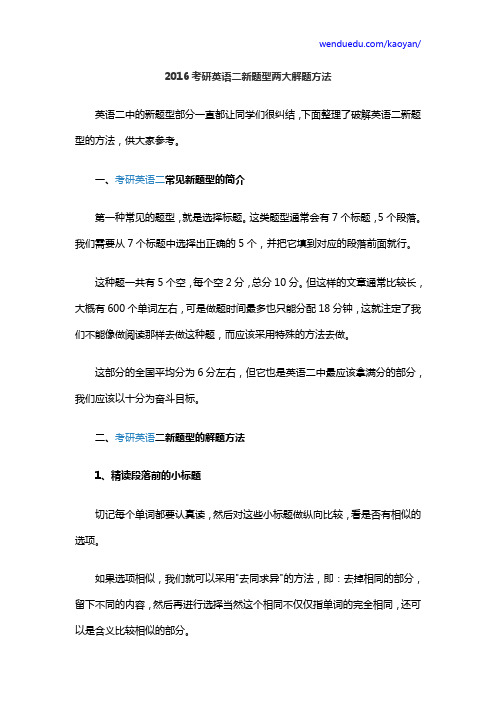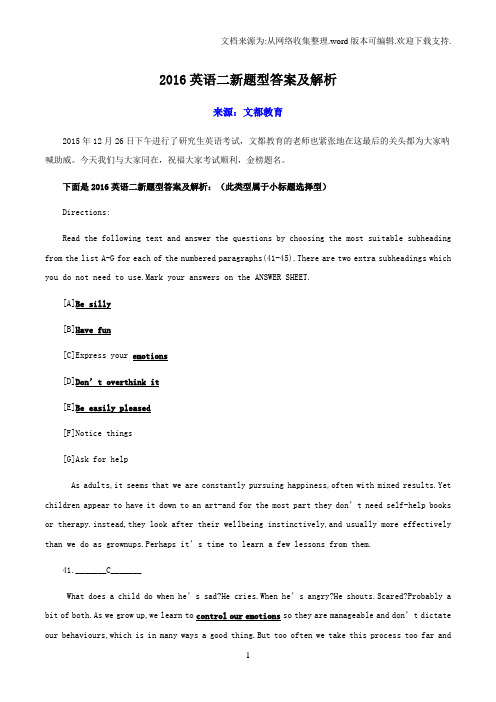2016考研英语二的新题型解密
- 格式:doc
- 大小:36.50 KB
- 文档页数:3

考研英语二的新题型与英语一的新题型相比,存在许多不同的地方,比如题型、测试目的、做题方法、得分率等等,但也有一些相同的地方,比如做题时间相同。
但总的来说,英语二的新题型比英语一的新题型略简单,也更容易得分。
今天,都教授将和大家一起学习2016考研英语二新题型中的选择填空题。
1.考研英语二新题型的简介 一般来说,英语二的新题型部分所选取的文章通常都比较长,大概在700单词之上。
也是有五道题,和七个选项,从七个选项中选择合适的五个选项,然后填到对应的空格中。
由于这类题目中的文章太长,因此不适合使用和做阅读一样的方法来解题。
不然,全文共五题,做一个题要把文章读一遍,这样全文就要读五遍。
这部分我们虽然是以10分为目标,但是也只有18分钟的时间,要是这样做下去,就会没有时间做其他的题型,这是非常得不偿失的。
2.考研英语二新题型的做题步骤 鉴于以上情况,都教授建议小伙伴们采用以下的步骤去做题: (1)一次性划出题干中的所有关键词。
一般来说,关键词通常指我们常说的人名、地名、时间名或者是组织机构名。
在考研英语二中,出现人名和组织机构名的可能性更大。
(2)浏览全文,找出各段中关键词出现的次数。
在浏览全文时,不需要详细理解每句话的意思,只要找到关键词出现的次数就行,比如第一次出现,就可以记做1次,第二次出现就可以记做2次,然后统计出现的总次数。
(3)先易后难 这种类型的题,在做的时候,按顺序做并不是明智的选择,相反,应该采用“先易后难”的做题方法。
这个做题的原则,很多小伙伴会说这个我们上小学的时候就知道,老师早就说过“先做容易的,后做难的”。
可是不看原文,我怎么知道哪个简单,哪个难呢?其实这个很容易,当关键词在文中只出现1次的时候,我们通过1次定位就能找到答案,然后直接将答案和选项重叠,就能知道这题选什么了;但如果文中关键词出现了好几次,那就需要通过多次定位,才能找到答案,在这个过程中,干扰项就会有很多,无疑也就增加了解题难度。

2016考研英语二新题型两大解题方法英语二中的新题型部分一直都让同学们很纠结,下面整理了破解英语二新题型的方法,供大家参考。
一、考研英语二常见新题型的简介第一种常见的题型,就是选择标题。
这类题型通常会有7个标题,5个段落。
我们需要从7个标题中选择出正确的5个,并把它填到对应的段落前面就行。
这种题一共有5个空,每个空2分,总分10分。
但这样的文章通常比较长,大概有600个单词左右,可是做题时间最多也只能分配18分钟,这就注定了我们不能像做阅读那样去做这种题,而应该采用特殊的方法去做。
这部分的全国平均分为6分左右,但它也是英语二中最应该拿满分的部分,我们应该以十分为奋斗目标。
二、考研英语二新题型的解题方法1、精读段落前的小标题切记每个单词都要认真读,然后对这些小标题做纵向比较,看是否有相似的选项。
如果选项相似,我们就可以采用"去同求异"的方法,即:去掉相同的部分,留下不同的内容,然后再进行选择当然这个相同不仅仅指单词的完全相同,还可以是含义比较相似的部分。
2、以段落为单位进行解题这个时候我们需要抓住段落大意,因而通读整段,了解段落的含义就行,遇到有不认识的生词可以直接跳过去,不用管它。
尤其是要重点看空格后的第一句,这对于我们解题至关重要。
如果空格后有两个段落的,只看第一个段落的大意就行,后面的一个段落不用去管。
【2016年考研英语点睛班】英语界“长难句王子”何凯文16考研直播课模考课,提供4篇绝密定制文章,训练解题思路、做题技巧,快速掌握阅读高分捷径,快速提升写作技巧,精准作文预测,经典实用模板,考前独家演绎!登录天猫,进入文都网校旗舰店,搜索课程“2016考研英语点睛班何凯文直播课文都网校视频课程阅读+写作”。

2016年全国硕士研究生入学统一考试英语(二)试题答案详解(完整版)Section I Use of English1、【答案】C how【解析】根据空格所在句子可以看出,空格处应该是一个引导宾语从句的从属连词,做influence的宾语。
四个选项的意思中,只有C. how引导后面的内容做influence的宾语,前后意思合理。
2、【答案】B In particular【解析】空格的前一句话的内容是:坐落在幸福人群所在地的公司投资更多的钱。
空格所在句的内容是:坐落在幸福人群所在地的公司在…方面投入更多的钱。
很显然,前后句子是总分关系。
选项中,只有B选项可以体现总分关系。
3、【答案】D necessary【解析】根据空格处前后的内容,_____ for making investments for the future是做后置定语修饰longer-term thinking和happiness。
幸福,这种持久的思维模式对于对未来进行投资_______,四个选项中只有D. necessary做后置定语符合前后内容。
其他选项与原文内容语义不符。
4、【答案】C optimism【解析】空格处的内容与inclination for risk-taking由and连接,构成并列关系,后面that come with happiness定语从句既修饰空格处的内容,也修饰inclination for risk-taking,所以选项中可以由that come with happiness修饰的只有C选项optimism。
5、【答案】D change【解析】空格处的内容和the way companies invested构成动宾搭配。
选项中A. echo 回声 B. miss 思念 C. spoil 溺爱 D. change 改变,所以只有D选项可以和the way companies invested构成通顺语义。

2016考研英语二真题及答案解析Section I Use of EnglishDirections:Read the following text。
Choose the best word(s)for each numbered blank and mark A,B,C or D on the ANSWER SHEET。
(10 points)Happy people work differently。
They’re more productive,more creative,and willing to take greater risks。
And new research suggests that happiness might influence1 firms work,too。
Companies located in place with happier people invest more,according to a recent research paper。
2 ,firms in happy places spend more on R&D(research and development)。
That’s because happiness is linked to the kind of longer-term thinking 3 for making investment for the future。
The researchers wanted to know if the 4 and inclination for risk-taking that come with happinesswould 5 the way companies invested。
So they compared U.S。
cities’average happiness 6 by Gallup polling with the investment activity of publicly traded firms in those areas。

2016考研英语二真题及详细解析Section 1 Use of EnglishDirections: Read the following text. Choose the best word(s) for each numbered blank and mark [A], [B], [C] or [D] on ANSWER SHEET 1. (10 points)Happy people work differently. They’re more productive, more cre ative, and willing to take greater risks. And new research suggests that happiness might influence__1__firm’s work, too.Companies located in places with happier people invest more, according to a recent research paper.__2__, firms in happy places spend more on R&D (research and development). That’s because happiness is linked to the kind of longer-term thinking__3__for making investments for the future.The researchers wanted to know if the__4__and inclination for risk-taking that come with happiness would__5__the way companies invested. So they compared U.S. cities’ average happiness__6__by Gallup polling with the investment activity of publicly traded firms in those areas.__7__enough, firms’ investment and R&D intensity were correlated with the h appiness of the area in which they were__8__.But is it really happiness that’s linked to investment, or could something else about happier cities__9__why firms there spend more on R&D? To find out, the researchers controlled for various__10__that might make firms more likely to invest – like size, industry, and sales – and for indicators that a place was__11__to live in, like growth in wages or population. The link between happiness and investment generally__12__even after accounting for these things.The correlation between happiness and investment was particularly strong for younger firms, which the authors__13__to “less codified decision making process” and the possible presence of “younger and less__14__managers who are more likely to be influenced by sentiment.” The relationship was__15__stronger in places where happiness was spread more__16__.Firms seem to invest more in places where most people are relatively happy, rather than in places with happiness inequality.__17__ this doesn’t prove that hap piness causes firms to invest more or to take a longer-term view, the authors believe it at least__18__at that possibility. It’s not hard to imagine that local culture and sentiment would help__19__how executives think about the future. “It surely seems plausible that happy people would be more forward-thinking and creative and__20__R&D more than the average,” said one researcher.1. [A] why [B] where [C] how [D] when2. [A] In return [B] In particular [C] In contrast [D] In conclusion3. [A] sufficient [B] famous [C] perfect [D] necessary4. [A] individualism [B] modernism [C] optimism [D] realism5. [A] echo [B] miss [C] spoil [D] change6. [A] imagined [B] measured [C] invented [D] assumed7. [A] Sure [B] Odd [C] Unfortunate [D] Often8. [A] advertised [B] divided [C] overtaxed [D] headquartered9. [A] explain [B] overstate [C] summarize [D] emphasize10. [A] stages [B] factors [C] levels [D] methods11. [A] desirable [B] sociable [C] reputable [D] reliable12. [A] resumed [B] held [C]emerged [D] broke13. [A] attribute [B] assign [C] transfer [D]compare14. [A] serious [B] civilized [C] ambitious [D]experienced15. [A] thus [B] instead [C] also [D] never16. [A] rapidly [B] regularly [C] directly [D] equally17. [A] After [B] Until [C] While [D] Since18. [A] arrives [B] jumps [C] hints [D] strikes19. [A] shape [B] rediscover [C] simplify [D] share20. [A] pray for [B] lean towards [C] give away [D] send out1. [标准答案] [C]how[考点分析] 连词辨析[选项分析] 根据语境,“新发现表明:快乐可能会影响工作__的稳定。

2016英语二新题型答案及解析来源:文都教育2015年12月26日下午进行了研究生英语考试,文都教育的老师也紧张地在这最后的关头都为大家呐喊助威。
今天我们与大家同在,祝福大家考试顺利,金榜题名。
下面是2016英语二新题型答案及解析:(此类型属于小标题选择型)Directions:Read the following text and answer the questions by choosing the most suitable subheading from the list A-G for each of the numbered paragraphs(41-45).There are two extra subheadings which you do not need to use.Mark your answers on the ANSWER SHEET.[A]Be silly[B]Have fun[C]Express your emotions[D]Don’t overthink it[E]Be easily pleased[F]Notice things[G]Ask for helpAs adults,it seems that we are constantly pursuing happiness,often with mixed results.Yet children appear to have it down to an art-and for the most part they don’t need self-help books or therapy.instead,they look after their wellbeing instinctively,and usually more effectively than we do as grownups.Perhaps it’s time to learn a few lessons from them.41._______C_______What does a child do when he’s sad?He cries.When he’s angry?He shouts.Scared?Probably a bit of both.As we grow up,we learn to control our emotions so they are manageable and don’t dictate our behaviours,which is in many ways a good thing.But too often we take this process too far andend up suppressing emotions,especially negative ones.that’s about as effective as brushing dirt under a carpet and can even make us ill.What we need to do is find a way to acknowledge and express what we feel appropriately,and then-again.like children-move.42.______E_______A couple of Christmases ago,my youngest stepdaughter,who was nine years old at the time ,got a Superman T-shirt for Christmas.It cost less than a fiver but she was overjoyed,and couldn’t stop talking about it.Too often we believe that a new job,bigger house or better car will be the magic silver bullet that will allow us to finally be content,but the reality is these things have very little lasting impact on our happiness levels.instead,being grateful for small things every day is a much better way to improve wellbeing.43._________A_____________Have you ever noticed how much children laugh?If we adults could indulge in a bit of silliness and giggling,we would reduce the stress hormones in our bodies increase good hormones like endorphins,improve blood flow to our hearts and even have a greater chance of fighting off enfection.All of which,of course,have a positive effect on happiness levels.44.________B___________The problem with being a grown up is that there’s an awful lot of serious stuff to deal with-work,mortgage payments,figuring out what to cook for dinner.But as adults we also have the luxury of being able to control our own diaries and it’s important that we schedule in time to enjoy the things we love.Those things might be social,sporting,creative or completely random(dancing aroud the living room,anyone?)——it doesn’t matter,so long as they’re enjoyable, and not likely to have negative side effects,such as drinking too much alcohol or going on a wild spending spree if you’re on a tight budget.45.________D___________Having said all of the above,it’s important to add that we shouldn’t try too hard to be happy.Scientists tell us this can backfire and actually have a negative impact on our wellbeing. As the Chinese philosopher Chuang Tzu is reported to have said:“Happiness is the absence of strivingfor happiness.”And in that,once more,we need to look to the example of our children,to whom happiness is not a goal but a natural by product of the way they live.解析:本文主要讲的是成年人不断追求幸福,但是结果往往是不清楚。
在上一篇文章中,我们已经就英语一中的阅读理解B,即新题型,已经和各位考生分享过了英语一里新题型的三种类型。
不同于英语一的三种备选题型,英语二的新题型主要包括:(1)多项对应,(2)小题目对应。
第一步:弄懂英语(二)新题型怎么考 首先,我们先来看一下在英语二的历年真题中,各种题型出现的比例。
除了第一年新题型中出现了判断正误外,之后的新题型已基本固定在多项对应和小标题对应这两种类型。
年份 类型 2010 判断正误 2011 多相对应 2012 多相对应 2013 小标题对应 2014 多相对应 2015 小标题对应 接下来,就这两种备选题型,和各位考生一起来分享这部分的一些知识和答题技巧。
多项对应及小标题对应都是选择长度为450-550词的文章,然后在给出的7个选项中找到符合题目要求的5个选项。
多项对应题型中,出题人会给出5道题目和7个选项。
该题型要求考生在通读全文后,根据文章内容和左栏中提供的信息从右栏中的7个选项中选出相对应的5项相关信息;小标题对应题型则是要求考生在根据文章内容和整个文章架构,在给出的7个选项中,选取最恰当的5个概括句或小标题填入文章预留的空白处。
第二步:明白英语(二)新题型如何做 英语二的新题型部分考查考生对文章连贯性、一致性及逻辑性的掌握。
同时考生若想在这一题型取得高分,需要掌握语篇和语段的整体性特征。
就英语二新题型的答题技巧来看,考生需要在对文章的整体性及逻辑性掌握之后,根据不同题型的特点对题目进行“各个击破”。
多项对应题目一般是在左栏给出论点,要求考生根据论点展开或是找到可以说明该论点的例子。
其中较为重要的是要始终保持语段的一致性。
因为论据是从文章中提取出来的,并且为论点服务。
这些论据既要和论点相关,还要可以证明论点;小标题考查考生对文章及段落的概括能力。
在这类题型中,考生需要注意出现在段落中的一些关键词,如原词、同义词或是反义词。
考生可以根据这些线索词来进行答题。
2016考研英语(二)六大题型命题趋势自考研英语(二)出现以来,陆续成为很多热门专硕的英语选择。
从难度上讲,英语(二)比英语(一)略简单,但这只是笼统的概念。
实际上,英语(二)的考点并不与英语(一)完全重合,相反,英语(二)有很多独特的知识点。
找准这些知识点重点复习,能够有效地提高英语(二)的成绩。
为了从总体上把握2016年考研英语(二)的命题趋势,明了命题者的意图和考查要点,我们对2014年12月份全国硕士研究生入学统一考试英语(二)试题的各个题型进行了考点分析,并与历年真题中的考点分析数据相结合,分别形成了以下分析图表。
►图表一:完型知识点考查分布由上表分析得出,词汇的考查在英语二完型填空中比在英语一中更加明显,比重占到了75%左右。
但从考查角度上分析,与英一区别很大,英二侧重对上下文语义的理解,选择词汇也是基于这一点,而不重在词汇之间的辨析,甚至连介词的考查也不是考查固定搭配而是重语篇内容的理解。
由此,对文章内容正确理解在英二完型中的重要性可见一斑。
对于2015年的完型题目来说更是如此,选项的干扰性不强,而且词汇不难,比往年要简单。
建议2016年的考生从现在就开始打好词汇基础,培养自己的阅读能力。
►图表二:阅读理解知识点考查分布由上表分析得出,细节题在英语二的考查项目中所占的比重相当大,也就是说重点考查考生对文章某个句子或段落的准确理解。
由此,可以看出英语二的要求比英语一要低,超纲的词汇不会考,同时英语一中对考生的八大阅读能力要求,英语二中少了“理解文中的概念性含义”和“区分论点和论据”这两条,所以猜词题和例证题并不是英语二的重点,建议考生要有针对性的复习。
►图表三:新题型知识点考查分布由上表分析得出,多项对应是英语二新题型重点考查的一个类型。
该备选题型是英语二的一大特色,属于名副其实的“新”题型,文章后面有左右两栏内容,左栏的5道题目属于半句表达,右栏的7个选项信息属于另半句表达,考生要从中选出5个与左栏构成完整的句子。
2016年全国硕士研究生入学统一考试英语(二)真题及解析(江南博哥)材料题根据下面资料,回答1-20题Happy people work differently. They're more productive, more creative, and willing to take greater risks. And new research suggests that happiness might influence1firms work, too.Companies located in place with happier people invest more, according to a recent research paper.2, firms in happy places spend more on R&D( research and development). That's because happiness is linked to the kind of longer-term thinking3for making investment for the future.The researchers wanted to know if the4and inclination for risk-taking that come with happiness would5the way companies invested.So they compared U. S. cities' average happiness6by Gallup polling with the investment activity of publicly traded firms in those areas.7enough, firms' investment and R&D intensity were correlated with the happiness of the area in which they were8. But is it really happiness that's linked to investment, or could something else about happier cities9why firms there spend more onR&D?To find out, the researchers controlled for various10that might make firms more likely to invest—like size, industry,and sales—and for indicators that a place was11to live in, like growth in wages or population. The link between happiness and investment generally12even after accounting for these things.The correlation between happiness and investment was particularly strong for younger firms, which the authors13to "less confined decision making process"and the possible presence of "younger and less14managers who are more likely to be influenced by sentiment. " The relationship was15stronger in places where happiness was spread more16. Firms seem to invest more in places where most people are relatively happy, rather than in places with happiness inequality.17this doesn't prove that happiness causes firms to invest more or to take alonger-term view, the authors believe it at least18at that possibility. It's not hard to imagine that local culture and sentiment would help19how executives think about the future. "It surely seems plausible that happy people would be moreforward-thinking and creative and20R&D more than the average, " said one researcher.1、[单选题]第(1)题选______.A.whyB.whereC.howD.when正确答案:C参考解析:空格句的大意:新的研究表明,幸福感可能也会影响公司______的工作。
2016考研英语(二)新题型真题及解题思路解析2016考研英语已经落下帷幕,跨考教育英语教研室仇老师为考生详细解析英语二的新题型真题,并给出此类题的答题思路,希望对2017考生备考有所帮助。
一、基本答题步骤首先,7个选项一定要写出中文意思做标注哦。
今年真题的选项中几乎没有生词。
意思也非常的简单,简洁明了。
其次,去关注第一道题目之前的文章内容对本文有一定的认识。
当然,根据以往的真题经验,我们无需全部看一遍,只需要看题目之前的一到两句就可以了。
接下来在每一段的总结过程中,需要大家按句子来划分,看看一段中,在绝大多数句子中重复的关键就是本段中心了。
掌握了这样的思路,我们就可以顺利的推出正确选项了。
二、真题解析接下来把2016的这篇新题型和大家一起来分享下:意料之中的小标题。
首先明确7个选项的意思。
首先应当把握本文的出发点,也就是41题目之前的关键句:我们应该从孩子身上学习一些东西。
“捉住本中心,每个标题都是提醒成人可以从孩子身上得到一些启示。
41题C 表达情感。
开头以问句的方式:“孩子悲伤时会怎样?孩子生气时会如何?他们的表达方式与大人不同,成人更多会选择压抑情感,并且会有不好的后果,比如致病。
紧接着最后一句算是总结句:我们要找到一种合适的方式表达,像孩子那样。
重点在哪里?整段不离的中心意思,重复的出现那就是情感的表达喽。
选项为C42.E举例子的目的无非是为了证明观点。
但是从例子也是可以总结出想要表达的意思的。
讲到一个小女孩因为一个廉价的圣诞礼物就可以高兴,并且很快乐,就旨在讲小小的幸福。
再来看看例子后面的观点。
提到成人的世界里所谓的车啊,房啊之类的貌似会让我们幸福的东西其实不然。
所以一个instead 直接把本段的中心意思表达了出来,那就是幸福来自于小小的事情。
对应选项E43. A 一句话出现在第二句。
问句之后,如果我们能够“愚蠢“那么一点点,我们将会有各种好处,对不对。
那么这一段几乎大段的篇幅都花在这一句上了,主旨更加明显那就是:去这样做吧。
2016考研英语二的新题型解密
考研英语新题型部分一直是许多考生头疼的部分,尤其是英语一的新题型,各种指代和上下文语境让小伙伴们摸不着头脑。
不过,值得庆幸的是,只有考研英语一的新题型如此,相比之下,英语二的新题型“友好”太多了。
今天,2016考研的小伙伴们就一起来探索下吧。
1.考研英语二新题型的简介
第一种常见的题型,就是选择标题。
这类题型通常会有7个标题,5个段落。
我们需要从7个标题中选择出正确的5个,并把它填到对应的段落前面就行。
这种题一共有5个空,每个空2分,总分10分。
但这样的文章通常比较长,大概有600个单词左右,可是做题时间最多也只能分配18分钟,这就注定了我们不能像做阅读那样去做这种题,而应该采用特殊的方法去做。
这部分的全国平均分为6分左右,但它也是英语二中最应该拿满分的部分,我们应该以十分为奋斗目标。
2.考研英语二新题型的解题方法
我们对于解题方法的提炼一般可以分为两种:第一,在有限的样本中寻找出一些片面的规律,这就是所谓的“江湖派”的做法,这种做法由于样本是有限的,因而得出的规律可能具有一定的片面性;第二,根据不同题型的测试目的而选择不同的做题方法,这是典型的“学院派”的做法,这一类型的学者比较注重科学研究,强调抓规律,因而可依赖性较强。
这也是我们经常选用的方法。
对于选择标题题来说,它的主要目的是考查段落大意,而不是文章大意,因而不需要通读全文;此外,这类题目还考查考生对于标题
的辨析能力。
既然考查辨析能力,那我们就要仔细去观察标题是否相近了。
因此,这些特点决定了这一类型的题目解题方法如下:
①精读段落前的小标题,切记每个单词都要认真读,然后对这些小标题做纵向比较,看是否有相似的选项。
如果选项相似,我们就可以采用“去同求异”的方法,即:去掉相同的部分,留下不同的内容,然后再进行选择当然这个相同不仅仅指单词的完全相同,还可以是含义比较相似的部分。
所以,小伙伴们要仔细看准了哦。
②以段落为单位进行解题。
这个时候我们需要抓住段落大意,因而通读整段,了解段落的含义就行,遇到有不认识的生词可以直接跳过去,不用管它。
尤其是要重点看空格后的第一句,这对于我们解题至关重要。
如果空格后有两个段落的,只看第一个段落的大意就行,后面的一个段落不用去管。
1.考研英语二新题型的简介
一般来说,英语二的新题型部分所选取的文章通常都比较长,大概在700单词之上。
也是有五道题,和七个选项,从七个选项中选择合适的五个选项,然后填到对应的空格中。
由于这类题目中的文章太长,因此不适合使用和做阅读一样的方法来解题。
不然,全文共五题,做一个题要把文章读一遍,这样全文就要读五遍。
这部分我们虽然是以10分为目标,但是也只有18分钟的时间,要是这样做下去,就会没有时间做其他的题型,这是非常得不偿失的。
2.考研英语二新题型的做题步骤
鉴于以上情况,都教授建议小伙伴们采用以下的步骤去做题:
(1)一次性划出题干中的所有关键词。
一般来说,关键词通常指我们常说的人名、地名、时间名或者是组织机构名。
在考研英语二中,出现人名和组织机构名的可能性更大。
(2)浏览全文,找出各段中关键词出现的次数。
在浏览全文时,不需要详细理解每句话的意思,只要找到关键词出现的次数就行,比如第一次出现,就可以记做1次,第二次出现就可以记做2次,然后统计出现的总次数。
(3)先易后难
这种类型的题,在做的时候,按顺序做并不是明智的选择,相反,应该采用“先易后难”的做题方法。
这个做题的原则,很多小伙伴会说这个我们上小学的时候就知道,老师早就说过“先做容易的,后做难的”。
可是不看原文,我怎么知道哪个简单,哪个难呢?其实这个很容易,当关键词在文中只出现1次的时候,我们通过1次定位就能找到答案,然后直接将答案和选项重叠,就能知道这题选什么了;但如果文中关键词出现了好几次,那就需要通过多次定位,才能找到答案,在这个过程中,干扰项就会有很多,无疑也就增加了解题难度。
所以,我们可以说,当关键词在文中只出现了1次,或者出现的次数较少的时候,这个题就属于比较简单的,可以放在最开始做,而出现次数最多的关键词,放在最后做就行了。
以上的做题方法和技巧,希望可以给在题海中漂泊,摸不着头脑的伙伴们带去一些福音,帮助大家在苦海之中找到方向,早日“上岸”。
祝大家2016考研金榜题名!。